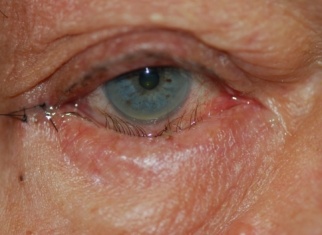
Entropion is an eyelid malposition in which the eyelid is inverted or turned inward completely and causes the eyelashes and skin to rub against the surface of the eye. This causes pain, irritation and foreign body sensation. In addition, entropion can cause corneal erosions, infectious ulcers and vision loss. Entropion is more common in older people and generally affects only the lower eyelid, although the upper eyelid can also be affected by this condition.
Entropion should not be confused with ectropion, which consists of the opposite, an outward turning of the eyelid, exposing the conjunctiva that covers it to the outside.
There are different types of entropion: involutional or senile, congenital, cicatricial and spastic:
Entropion is usually associated with tissue aging. However, there are different causes depending on the type of entropion:
The symptoms of entropion result from the eyelashes and the skin of the outer eyelid rubbing against the surface of the eye:
If the situation persists, erosions, eye infections such as ulcers and even corneal scarring may occur, so you need to be treated before serious eye damage occurs.
The definitive treatment is surgery. The surgery is performed on an outpatient basis without hospitalization, under local anesthesia with sedation or general anesthesia in children, and consists of stabilizing the eyelid so that it does not turn inwards. There are different surgical techniques, which are applied according to the nature, position and severity of the entropion. Recovery is usually quite fast and any bruising from the surgery disappears in a short period of time. Symptoms disappear soon after surgery.
Some treatments may partially alleviate symptoms in the days prior to surgery, such as lubricating the eye with eye drops and ointments or using adhesive tape arranged vertically to prevent inversion of the entire palpebral margin.

No, the definitive treatment for entropion is surgery. Treatments such as eye lubrication and vertical adhesive tape may partially relieve symptoms prior to surgery, but do not completely cure entropion.
The only treatment to permanently cure entropion is surgery. However, botulinum toxin can temporarily treat spastic entropion, improving it, without curing it, for a few weeks. This option is only reserved for patients who cannot be operated on and have this type of entropion.
Usually an intervention is enough to solve the problem. However, there may be some rare cases of recurrence and failure of surgery, which will be evaluated by your oculoplastic surgeon to find the most appropriate solution.
If entropion is not treated in time, it can cause permanent vision loss due to the potentially very serious corneal damage.
In general, entropion is not preventable. The only case where it is possible to prevent it is entropion caused by trachoma, a bacterial infection. In this case, if you have redness and irritation in an area of the eye, and you live in a place where trachoma is frequent, you should visit your ophthalmologist to treat it before it causes eyelid damage.
You should visit your ophthalmologist if you constantly notice any kind of rubbing in your eye or notice that your eyelashes are turning towards your eye. You should also see your eye doctor if you have already been diagnosed with entropion and you have rapidly increasing redness in your eyes, pain, sensitivity to light or decreased vision.
It is recommended that the operation be performed by an oculoplastic surgeon and not a general practitioner, since the oculoplastic surgeon is an ophthalmologist specialized in eyelid surgeries, knows the palpebral anatomy, the causes of the pathologies and their solutions, so he/she will take special care of the eye to preserve its vital function.
Congenital entropion is due to genetic problems, so it can be inherited. However, the vast majority are not hereditary and there are other factors that cause entropion such as age, burns or scars.
Entropion is diagnosed by routine eye examination. Your doctor may ask you to close your eyes or move and feel your eyelid. These movements will help to see the exact position of the eyelid relative to the eye, the tension of the eyelid tendon, its tone and elasticity. In case the entropion is cicatricial, the doctor will also examine the conjunctival tissue that covers it.
Contact us or request an appointment with our medical team.